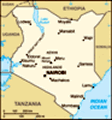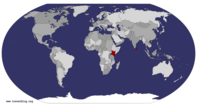Advertisement
Published: January 28th 2008
We set off early from Nairobi to Amboseli. Nick, our driver is excellent which is fortunate seeing as he’ll be driving us for about 8hours a day over the next week!
I am sharing the van with 2 older couples, both farmers and also members of a closed harmony singing group although no sign of them breaking into song as yet! I have managed to bag the front seat next to the driver.
We arrived at Amboseli national park at about midday. During the journey I did not see examples of extreme poverty. In many ways the streets, shops, houses and people milling, working and playing on the streets seem less of a hit on the senses than what I saw in Goa. I think that is partly down to the fact that in India the amount of people per sq km is so greater that the noise and scene seems more overpowering.
Arriving at Amboseli we were accosted by lots of Masai Mara tribesmen, one of whom kindly told me the Liverpool score at the weekend!
Talking to them it seemed the kenyan people had a low deep rich voice. Words were delivered tunefully and the language

 Birdlife
Birdlife
Kingfisher, I believeseemed to have a rhythm to it.
Driving through the park to the lodge where we were to stay we saw various types of birds, elephants, wildebeest, gazelles, hippo’s zebra and buffalo. On arrival we had lunch and I sat down with 6 people from another minibus and had lunch and chatted with them which was cool as it makes me socialise a bit.
The site itself is fantastic. There is a large veranda bar and pool area that literally looks out onto the jungle. Sundowners is the time for all tourists to have got back from the afternoon game drive and have a quick shower and then get out onto that veranda, order a few stiff drinks and relax as the sun goes down and the view out to that open jungle takes on more mysterious hues as the light changes.
The vegetation colours of green, yellow and darker images merge with the noise of animals calling for love, protection, food and aggression. As it becomes more difficult to make out actual shapes you wonder what that is moving in the distance. Is it a Rhino? A Lion? Probably just a gazelle. Apparently, I was told,
Amboseli has only just had rain for the 1st time in a year, this has bought the frogs and crickets out and the noise is tremendous!
The 1st game drive this afternoon was quality. We are in an 8 seater minibus with convertible roof that is let down to allow the 5 passengers in the back to stand up. The barrier or roof is about waist height which allows the passenger to lean against the roof and look around safely at the animals and landscape on safari. The highlight was seeing 4 young adult female lions lying symmetrically in position overseeing a dead
Half eaten wildebeest surrounded by circling hyenas. We saw a group of elephants passing close by. Then as we were journeying towards home there was a small movement about 70 yards away in the undergrowth spotted by Nick the driver. We eagerly strained our necks and concentrated to spot a movement and then follow it up with our binoculars and there just able to be seen were 3 leopards plotted up behind some long grasses. It was difficult to see them with the binoculars so there was no chance of a photo but they were

 Elephants
Elephants
The adults protecting childrendefinitely leopards and could be glimpsed when they stretched or moved. When they were still it was impossible to see them as they blended in with the vegetation as if they were vegetation themselves.
This was a great start and we headed back to the lodge as the sunset with Mount Kilamanjaro in the distance obscured by clouds. A marvellous day but I am pretty worn out. Time for a good kip and then up at the crack of dawn for more safari antics!
9th November
Awoke at 06.00 and after a quick cup of tea we were off in the van away on a game drive. The early morning gave us clear blue skies. The landscape is flat with very little tree cover, quite barren. Driving along the flat dusty track I could see a slightly raised rock crevice with a hyena prowling at the top on the lip of the rock covering a little hyena pup. Under the rock crevice was clearly a tunnel through to their underground den.
On our return I came back and had a hearty breakfast and then got ready for an excursion out to a tribal village. We were
met by the tribal chief who explained to us that the initial welcome we were about to be given was not just something for tourists but a display that the tribe, whose history and mode of contact is ubiquitous by having very little contact or interference form outsiders, would produce for any human party attempting to enter their settlement.
The tribesmen and women were lined up in one long row, women starting from the left and joined in time by the men. The men were chanting in harmony. A very nice sound. The women were also contributing a different noise aiding the overall sound, which was tuneful. The tribesmen were jumping high from a standing position like jack in the boxes and, from time to time charging us with their spears. The men were wearing only really a long skirt made out of a red material tied round their waist and ivory jewellery. The women were also mainly in red and had their heads shaved. They wore more decorative jewellery and at times the amount of earrings in one ear must have been upward of 20.
After the ceremony the tribal leader led us into the village and
he explained some of the villages customs to us. In the middle of the village was a pen for the cows and goats to sleep in to protect them from attack by carnivorous prey. It was made of a spiky bush that would not encourage an animal to continue too much. The village itself also had a ring of these trees and other hardy bushes to protect from incursion from various inquisitive animals.
The mud huts are made of mud obviously and the frames of pliable Acacia wood and the outside covered by dried cow dung. If the structure is well made they are quite capable of lasting for 20 years. The Masai tribesmen are a nomadic people so periodically they leave one settlement for another but it is common practice to leave each settlement in good condition because if one is seen to be free by a passing tribe then they may take up settlement there for a time.
The tribeswomen make the huts. A man may have as many wives as he can afford. The tribal leader who was addressing us had 3. Cows are extremely important. The tribes diet consisted of just 3 items; milk,
cow meat and cow blood. That is it. It’s all your getting! The men make the fire and hunt. We were shown various types of natural medicine made from native plants. One item was a root to help make women thinner when pregnant to enable easier birth. There was also another potion to help male virility and the chief imparted a knowing look when he talked of this causing a middle-aged woman close to me too blush!
After this fascinating visit we returned to the Lodge for lunch and a bit later another game drive. Driving through the fairly solid straightforward tracks there are many carcasses to be seen. It seems like the equivalent of seeing a burnt out engine or exhaust lying on the side of the road! Later on in the evening at dinner, between the Oxtail soup and the Sirloin steak a hippo trotted up out of the tree cover and paraded around on show under the restaurant lights.
This final game drive at Amboseli was remarkable and displayed a wide variety of game to us. Just as dusk was closing in 3 hippos emerged from the water where they had been keeping
cool. This was special because previously we had seen hippos only submerged in water. On this occasion we could appreciate the huge size of them and their slow powerful movement. Earlier we had glimpsed 3 leopards eating a kill, so hard to see and tell apart from the camouflaged background.
The highlight of this drive was seeing a Lioness and 4 of her cubs that were about 5 months old. They were 30 metres away lying on dust near some longer grass and completely out in the open and not in the slightest bothered about the 6 safari vans milling about around them. Amboseli itself is quite a bleak landscape. There is little forest cover and it must be a difficult environment for the animals as there is little cover to protect them from being stalked or to aid the stalkers. Of course the animals prefer to hunt in the night or at dusk when the fast changing light gives them the advantage. I could see a lot of dead trees that must have been hit by lightning standing solitary, rising up from the plains with no other trees to be seen in the distance.
Advertisement
Tot: 0.081s; Tpl: 0.016s; cc: 10; qc: 49; dbt: 0.0475s; 1; m:domysql w:travelblog (10.17.0.13); sld: 1;
; mem: 1.2mb









